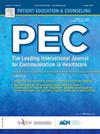Parents’ perspectives on cost conversations in pediatric asthma care: Findings from a qualitative interview study
IF 3.1
2区 医学
Q2 PUBLIC, ENVIRONMENTAL & OCCUPATIONAL HEALTH
引用次数: 0
Abstract
Objectives
Asthma care teams may be well-positioned to help parents navigate the high cost of pediatric asthma care, but little is known about how cost concerns are addressed in specialty clinics. To inform future interventions to support cost conversations and reduce cost burden, we sought to understand how parents and asthma care teams discuss costs, as well as parents’ preferences for cost conversations.
Methods
We interviewed 21 parents with asthma care cost concerns recruited from a large pediatric asthma specialty clinic in North Carolina. We used thematic analysis to qualitatively describe parents’ experiences of and preferences for cost conversations.
Results
Parents described incurring a range of direct and indirect asthma care costs, with direct costs being especially burdensome for commercially-insured children. Parents wanted cost conversations to be a routine part of office visits to reduce assumptions and stigma about their ability to afford care. Yet, cost conversations were inconsistent. When cost conversations did occur, the care team often found ways to reduce costs, such as switching to lower-cost medications. Most parents believed that both families and the asthma care team would benefit from having more cost-related information. Parents had mixed views on having cost conversations in front of their children.
Conclusions
Findings of our qualitative study suggest that asthma care teams have opportunities to address and destigmatize parents’ financial concerns by making cost conversations part of routine care.
Practice implications
Parents want asthma care teams to regularly initiate cost of care conversations, while carefully considering their preferences for privacy when discussing costs in front of children. Parents and care teams likely need more information about costs and available resources to maximize the impact of these conversations.
父母对儿科哮喘护理成本对话的看法:一项定性访谈研究的结果
目的哮喘护理团队可以很好地帮助家长应对儿科哮喘护理的高成本,但对于专业诊所如何解决成本问题知之甚少。为了告知未来的干预措施,以支持成本对话和减少成本负担,我们试图了解父母和哮喘护理团队如何讨论成本,以及父母对成本对话的偏好。方法:我们从北卡罗莱纳州的一家大型儿科哮喘专科诊所招募了21名有哮喘护理费用问题的家长。我们使用主题分析来定性地描述父母对成本对话的经历和偏好。结果父母描述了一系列直接和间接的哮喘护理费用,其中直接费用对商业保险的儿童尤其沉重。家长们希望费用对话成为办公室访问的常规部分,以减少对他们负担医疗能力的假设和耻辱。然而,成本对话是不一致的。当成本对话发生时,护理团队通常会找到降低成本的方法,比如改用成本较低的药物。大多数家长认为,家庭和哮喘护理团队都将受益于更多与成本相关的信息。家长们对在孩子面前进行成本对话的看法不一。我们的定性研究结果表明,哮喘护理团队有机会通过将成本对话作为常规护理的一部分来解决和消除家长的经济担忧。实践意义父母希望哮喘护理团队定期启动护理费用对话,同时在孩子面前讨论费用时仔细考虑他们对隐私的偏好。父母和护理团队可能需要更多关于成本和可用资源的信息,以最大限度地发挥这些对话的影响。
本文章由计算机程序翻译,如有差异,请以英文原文为准。
求助全文
约1分钟内获得全文
求助全文
来源期刊

Patient Education and Counseling
医学-公共卫生、环境卫生与职业卫生
CiteScore
5.60
自引率
11.40%
发文量
384
审稿时长
46 days
期刊介绍:
Patient Education and Counseling is an interdisciplinary, international journal for patient education and health promotion researchers, managers and clinicians. The journal seeks to explore and elucidate the educational, counseling and communication models in health care. Its aim is to provide a forum for fundamental as well as applied research, and to promote the study of organizational issues involved with the delivery of patient education, counseling, health promotion services and training models in improving communication between providers and patients.
 求助内容:
求助内容: 应助结果提醒方式:
应助结果提醒方式:


